
|
if your browser doesn't support the menu, please use the links at the
bottom of the pages
|
||

|
|
||
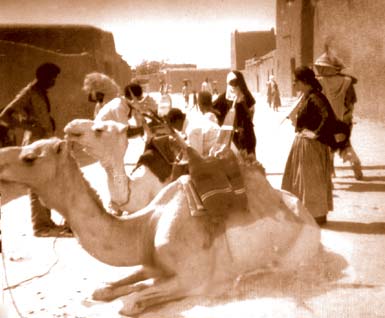 |
||
admiring the new traveling companions in the
street out front |
||
| |
||
"jamel" |
||
|
||
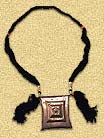 |
||
| Our original plan had been to travel west from Niger towards Mali and our goal, Timbuktu, but we were warned by the locals about the impossibility of such an undertaking. Not only would there be no water and no paths to follow, but it would also be highly illegal to just cross the border somewhere out in the desert. Additionally, the border regions were teaming with bandits that didn't think twice about doing away with adventurers foolish enough not to travel under the protection a big caravan afforded. As to caravans, there wasn't any; no Tuareg of sane mind would even think of traversing such a huge expanse of the Sahel during the hottest time of the year. | ||
Instead, we were advised to travel in southwestern direction to Niamey, the capital of Niger, and to continue up to Mali from there via Benin, Togo, Ghana and Burkina Faso. We thought it prudent to heed that advice from people who evidently knew what they were talking about, even if it meant traveling a less adventurous route, one where also the occasional truck would pass. |
||
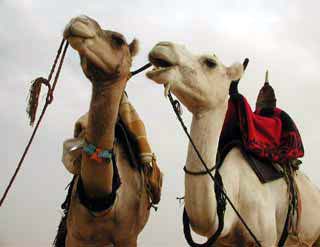 |
||
|
two animals looking uncannily like ours: |
||
| Actually we should have bought a third animal to carry our baggage and the drinking water, but we couldn't afford to. We knew we had to carry enough water with us to last from one village to the next, and also, both X and me being great book lovers, we had brought a heavy bag full of books and comics along to Africa. | ||
| Due to the drought, there was no fresh grass for the camels to feed on. This meant we had to purchase their daily load of hay at a pretty stiff price. Altogether we spent much more money than we had expected, so we had to sell our suitcase and the cassette recorder. |
||
 |
||
typical camel market in Niger's Sahel region;
photo:web |
||
| There was nothing romantic about our relationship, it was a plain master-subject kind of an affair. It's hardly possible to love an animal that obviously hates you. The best you can aim at is a temporary armistice, to be broken at the first opportunity. The haughtiness of the camel is said to be due to the fact that 99 names of God are known to humans, while only the camel knows the 100st name. | ||
| Nowadays of course there are specially trained and tamed camels available for tourists, but back in 1974 there were hardly enough foreigners passing through Niger for such efforts to be worth the trouble. We only met one small group of travelers in our six weeks at Ingal who had actually rented camels somewhere in Niger for an afternoon of sightseeing. | ||
 |
||
| Camel saddles in Niger are made from wood covered by a tight-fitting layer of dyed and painted leather. Our second saddle was very special, embellished with tassels and mirrors. We later sent it to my now ex-mother-in-law, where it graced her living room, with a bowl of sweets placed on it. I can't remember having seen it when I last visited her a few years back, she probably disposed of it out when she moved to her new apartment. I'd have loved to take it back, but currently she's not at speaking terms with me. |
||
| The slender back of the saddle is for ornamental purposes; it's not meant to be leaned upon. During my researches for this section I actually found a site owned by an American traveler who mentions that the back of the saddle is to support the rider. That's plain bullshit! The rider's back, while riding, is hardly even in contact with the saddle. The rider supports himself and keeps his balance solely via the feet of his loosely crossed legs on the camel's neck. | ||
| It's different with the three-pronged piece in front, this does have an important purpose. It's there to prevent an angry camel from biting its rider. Pulling the camels head right back towards that fork makes it impossible for it to turn its neck around to bite. | ||
| The saddle itself sits right in front of the camel's hump, and is fastened tightly with a leather belt encircling the animal's belly. Underneath the saddle some doubled blankets are placed. The goatskins with the water and all the other pieces of luggage are tied to the saddle. | ||
| To mount the camel, it must be coached down to a sitting position by a few pulls to the cord connected to its nose ring. Next its mouth and nostrils are forcefully grabbed in a full handed grip and its head bent backwards to the side. Only now can the animal be mounted. The camel's bent foreleg is used as a step for the left foot, and the other leg is swung over the saddle. Once in the saddle, the legs are loosely crossed and the feet firmly positioned on the camel's neck to keep the rider's balance. All the while the grip on the camel's nose has to be kept. The moment it's loosened the animal jumps up, and if the rider hasn't positioned his feet where he ought to yet, he'll fly through the air towards a hard landing. It happened once to X while still at Ingal and once to me at the end of our journey. | ||
|
||
 |
||
the correct positioning of the feet is clearly
visible here; photo: web |
||
| When the rider is properly seated he lets go of the camel's head. The camel rises, straightening its hind legs first, thrusting the rider forward with a jolt. Then it straightens its front legs and lifts its rider about two meters above ground. | ||
| Riding a camel is a unique experience; it's quite different from riding a horse. The camel moves in a parallel fashion with both legs of the same side, while the horse advances the front leg of one side together with the hind leg of the other side. That is why the typical back and forth swaying movement in camel riding is different to that of horse riding. | ||
 |
||
| Which procedure was suitable for what kind of illness wasn't clear though; communication was on too basic a level for detailed explanations. | ||
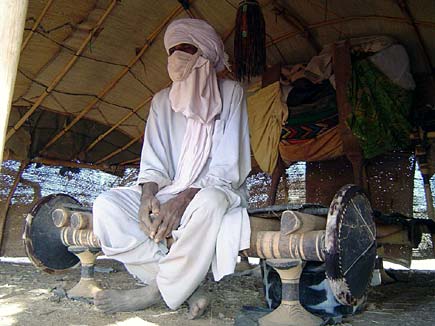 |
||
Tuareg sitting on his bed; photo: web |
||
 |
||
| Of the latter, in powdered form, there was an ample supply evident in one of the corners of the tent; it didn't take much imagination to understand that the amount of rations the chief had in surplus must be lacking in the tents of the less prominent members of his tribe. | ||
| As it was too dark to ride back to Ingal the same day, we spent the night at the camp. The next morning, the tribe's women plaited my hair into small plaits, the way they wore it themselves. Only it didn't look half as nice on me as it did on them; I'm not blessed with such abundant and thick hair as they are. | ||
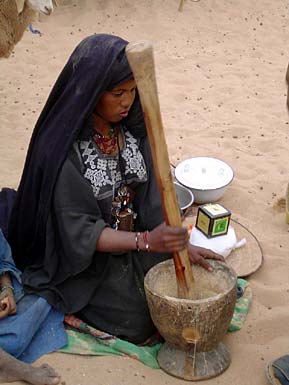 |
||
Tuareg mother at her chores; photo:
web |
||
| We repeatedly had the impression that in all the countries we visited in West Africa, material gain was of far greater importance to the inhabitants than striking up new friendships. This impression was confirmed on many occasions by foreign volunteers, like members of the Peace Corps, that we met and talked too. One functionary of a nonprofit organization, who in the course of his work frequently had to attend receptions, told us that on being introduced to a native, he himself would offer his name while his new acquaintance's first sentence usually was along the lines of: "Can you get me a cassette recorder?" | ||
| Such an attitude was difficult to get used to; wherever we had traveled before coming to Africa, we had always had memorable conversations with locals eager to share their thoughts, to philosophize and to generally talk about any subject between heaven and earth. It took time to get used to people not even asking us where we came from, and never having to answer that most typical sentence heard a thousand times in India or Pakistan: "What is the purpose of your visit?" | ||
| A quote from the homepage of Mr. Galen R. Frysinger, an experienced traveler: "From the children, who once received a well intentioned gift, but have an expectation of "gift" demanded of any stranger they meet, to the overaggressive seller of crudely fashioned metal trinkets, to the masked armed bandits cry of "Give ME Money", the expectation is to GET" | ||
I can only concord with Mr. Frysinger's observations. |
||
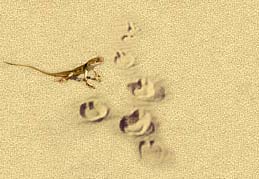 |
||
back to main index |
||